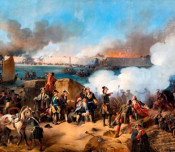
Marking the 350th anniversary of Peter the Great: Exhibition “Peter I and Russian Army” open in St. Petersburg
Exhibition “Peter I and Russian Army” has been opened at the Military Historical Museum of Artillery, Engineers and Signal Corps (St. Petersburg).
Exhibition is dedicated to the 350th anniversary since the birth of the first Russian Emperor Peter the Great (1672-1725). His name is intertwined with the history of the Museum, which collections were founded on August 29, 1703. On that day, by the decree of Peter I, the construction of Zeughaus for storage of unique historical samples of weaponry, old Russian and trophy weapons for the “memory for eternal glory” has started on the territory of St. Petersburg Fortress.
Exhibits tell about the history of Russian army in the end of XVII – first quarter of XVIII centuries, from the “fun” military games of Tsarevich Peter until the end of the Persian campaign.
The most valuable of them are the personal belongings of Emperor Peter Alexeyevich. Those are 20 authentic memorial pieces from the Museum’s collection. For example, the small cannon of young Tsarevich Peter is displayed here. It was molded in the second half of XVII century and given to Peter as a gift from his father, Tsar Alexey Mikhaylovich.
Another memorial weapon is the officer’s partisan that Peter I used in the Azov campaigns. Later, under the name of Commander Peter Alexeev, he carried this partisan in the march of Navy Regiment during the solemn arrival of Russian troops in Moscow on September 30, 1696, after the capture of Azov.
Another Peter I’s partisan has been preserved. It was awarded to him by the Commander-in-Chief of Russian Army, General Field Marshal B. P. Sheremetev during the conferment of the colonel (senior lieutenant general) rank of the Preobrazhensky Life Guards Regiment in 1706. The partisan has been sent to Tsar as a gift from Moscow by the Prince Caesar F. Y. Romodanovsky, with the charter on Tsar’s promotion to colonel.
Peter the Great’s full dress uniform is especially interesting. It included the camisole of the Foot Guards of 1720, waist and shoulder belts, and the officer’s scarf. During the reign of Peter I, the European scarf became one of the elements of Russian military uniform, and insignia of the officers. Until 1700s, the scarves of Peter’s army didn’t have an assigned color, but later they were sewed of the white, blue and red silk.
The biggest section of the exhibition is dedicated to the events of the Great Northern War (1700-1721), when young Russian State engaged unbeatable Sweden. Facing the bitterness of defeats and the joy of victories, Peter I crushed the Swedes in the Battle of Poltava, conquered the Baltics and Finland, lead the successful campaigns in Northern Germany and on the Baltic Sea. The ground operations of Peter’s army and navy forced Sweden to sign the triumphal for Russia Treaty of Nystad.
Exposition features a large amount of all types of weapons of the opposing parties: halberds and baginets, sabers and bayonets, mortars and hand mortars, shotguns and muskets, pistols and blunderbusses…
Exhibition also showcases the rarity related to the death of King Charles XII, the Peter I’s rival in the Great Northern War. It is a hunting rifle (stutzen) that belonged to the old baronial family von Kaulbars and was kept in their estate in Estland. According to legend, this rifle was used to kill the Swedish king near the Fredriksten Fortress on November 30, 1718.
Visitors will also have an opportunity to see Russian and Swedish drums and banners, headwear and uniforms.
The display is complemented by lithographs depicting clothes and weapons of Russian troops.
Overall, the exhibition features more than 300 unique historical items of Peter’s era, many of which are the only copies left in the world. Most of them have their own history and are displayed for the first time.
Exhibition “Peter the Great and Russian Army” will run in the Museum of Artillery until spring 2023.

